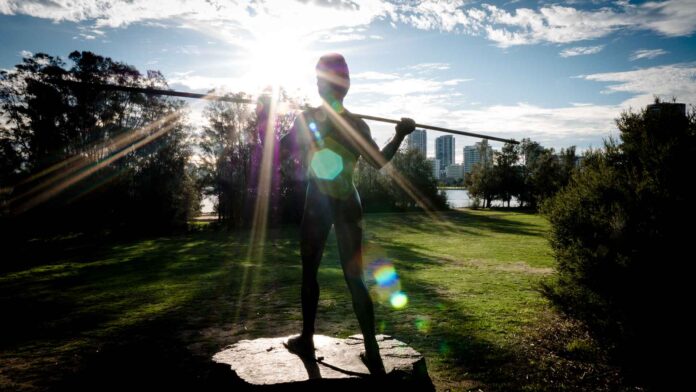Yagan’s story is one that has rippled through the history of Western Australia. It is a story that begins in 1829 at the start of the Swan River Colony and still reverberates in Australian society today. It is a story of country, of settlement, of invasion. A story of revenge, daring, escape and capture. A story of language, of family, friends, and fear. It is a story that captures the fundamental differences and misunderstandings that paved the way for conflict between early settlers and the Noongar nations of Western Australia.
In May of 1829 the first European settlers arrived in Western Australia and established the Swan River Colony around what is today’s Perth. At the time and for thousands of years previously, the area around the Swan River was inhabited by different Noongar (local aboriginal) nations or tribes. Initial accounts point towards a relatively peaceful coexistence between the Noongar and the settlers. However, that was not to last.
One local Whadjuk Noongar man stood out amongst his people. His name was Yagan, the son of a Beeliar chief – Midegooroo. Yagan was a tall, powerfully built, charming and intelligent man that would become both feared and respected by the early settlers.
As more and more settlers arrived the prime food and agricultural sites around the Swan were developed for farmland and fenced off. Land that had been used by the Noongar for thousands of years was suddenly no longer accessible.
The idea of fences, land ownership and food hoarding were completely foreign and incomprehensible to the Noongar. For tens of thousands of years, the Noongar had developed a complex and extensive knowledge of the land, its seasons, fire management, and food cultivation. The land (boodjar) was sacred, shared, and the animals and plant life were only taken as needed.
When food was becoming scarce due to settlement, the Noongar thought it only natural to help themselves to a farmer’s crop. What followed would set in motion a series of events that would take place over 160 years and cross continents.
In December 1831 in the blistering Western Australian sun, a farm hand by the name of Thomas Smedley looked out onto his master’s field and saw a group of Noongars ‘stealing’ potato’s. Thomas raised his rifle and fired, killing one of Yagan’s companions. The group of Noongars fled but Yagan would return to the farm the next day.
Gathering his father and a group of warriors, Yagan attacked the farmhouse to bring justice for his murdered friend. In Noongar law, if one tribe kills a member of the another, they have the right to kill a member of the attacking tribe. An eye for an eye and a tooth for a tooth.
While Thomas Smedley was not there when Yagan arrived, another servant was named Entwhisle was the unlucky focus of Noongar retribution. He was speared to death.
To the settlers, this killing represented an unprovoked killing of an innocent man. To the Noongar, his death was payment for the death of one of their own. These events would signal a change in relationship between the two groups that can still be felt today.
Yagan was declared public enemy number one and a bounty of 20 pounds was placed on his head. 20 pounds was about a year’s wages to a common worker, so more than enough to entice settlers into action.
While the army had been sent to hunt Yagan down, hunting a Noongar in his country is like hunting a ghost. For months no one came close to capturing Yagan. But as time went past and the being army recalled, Yagan began to frequent many of his old areas.
A group of settler fisherman recognised Yagan as he was travelling with two companions. After some enticement and promises of passage across the river the fisherman lured Yagan and his companions onto their boat. Whilst in deep water, with nowhere to run to, the fisherman headed directly to Fremantle round house where Yagan was locked up.
In chains and with execution looming, an unlikely advocate for Yagan and his companions came to their defence. A settler by the name of Robert Lyon. Lyon,a Scotsman, military man and later reverend, likened the Noongar plight to that of the Scottish rebels fighting the English. He saw in Yagan a William Wallace of his people and understood that the Noongar were fighting for their land and were angry at being displaced.
Lyon argued that they should be exiled instead of executed and that he would accompany them to learn their language and culture so to progress understanding between the two peoples. Captain James Stirling agreed and Yagan were sent to Carnac Island.
For six weeks, Robert Lyon began to learn the Noongar language and customs. Keeping meticulous notes and studying the mannerisms of the Yagan and his companions. This exchange of knowledge would be some of the first that took place between early colonial settlers and a member of the Noongar Nations.
However, Yagan and his companions soon yearned for their own country. Noongars have a deep sense of connection to their land and their spirits, souls and laws are sewn into its very fabric. One night, the three Noongar men stole an unguarded boat and sailed back to their country.
The situation between Noongar and Settler had not improved since Yagan’s exile and growing fear and distrust was growing on both sides. Food shortages led to many altercations and eventual killings. Yagan’s brother, whilst taking flour from stores in Fremantle was shot and killed.
Yagan’s revenge was inevitable. As two brothers, Tom and John Velvick, who had a history of abuse against locals, rode on a provisions cart through the countryside at sunset, a group of Noongars attacked. Both brothers were killed, with one brother being stabbed over a hundred times. The viciousness of the killings mirrored the pain and anger Yagan must have felt at the loss of his own brother.
While retribution had been carried out, Yagan and his group were now the most wanted men in the West of Australia and large bounties placed on their heads. Knowing their presence in their traditional lands would be dangerous, the group fled to the hills north east of Perth.
As the months passed, Yagan’s legend grew. Numerous stories were published in the local paper and the daring escapes, attacks and the intelligence and charisma of the man had started to create some sympathy for him amongst the settlers. However, the fear of Yagan and the capabilities of the Noongar also grew amongst others. The settlers had no way of knowing how many Noongar lived in the area and there was fear that the entire colony could be pushed back into the sea. The authorities were becoming more aggressive to the local Noongar.
Yagan’s father was eventually captured and taken to Perth where he was given a mock trial and sentenced to death by firing squad. The whole process of trial and execution lasted no more than 30 minutes. And so, Midegooroo, one of the most influential and important chiefs of the region was put to death.
It’s believed that word of Yagan’s fathers’ execution had not reached him as he would later return to areas previously frequented by him. Conversing with farmers and being sighted frequently, Yagan still had a 30-pound bounty on his head that would be too much for some to pass up.
Yagan and some companions came across two young brothers; William and James Keates. The young brothers were well acquainted with Yagan and knew some of his companions also. The brothers are believed to have sat down with Yagan and his companions for a meal. They waited until Yagan had his back turned, and the older brother, William fired his rifle, killing Yagan where he stood. The youngest brother fired a shot at a man named Heegan, hitting him in the head.
The boys fled to the river, being chased by the rest of Yagan’s companions. James made it to the river and began swimming, while he looked back to the shore he saw his brother surrounded and being speared multiple times.
The local paper recounts the grizzly details of what occurred and what awaited the men who went to investigate the aftermath: https://trove.nla.gov.au/newspaper/article/641988
The article also provides some interesting insights into the feelings of some settlers towards the Noongar. With the brother’s master, a Mr Bull giving strict orders for none of his staff to shoot Yagan. There also seems to be a sense of regret at the manner of which Yagan met his end and the foolishness of the brothers for undertaking it.
Yagan was dead. The charismatic, intelligent, powerful and skilled warrior of the Noongar nations was shot in the back and killed. However, this is not where Yagan’s story ends. His body would be mutilated, and his head sent to England. His spirit would not find rest for another 160 years.
Find out more in Part 2 coming soon.
Back Home

